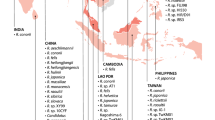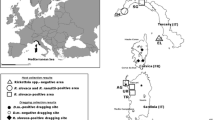Abstract
The past ten years were characterized by the appearance of several “new” transmissible spotted fever group (SFG) rickettsioses, e.g. Israeli, Japanese and Astrakhan fevers. The factors responsible for their establishment probably include the introduction of chemicals from industry, agriculture and the timber industry into natural habitats. Such factors may influence the pathogenicity of these rickettsiae. In this case, in addition to the human influence, the mechanism of the circulation of the agents under natural conditions of both abiotic (climate, etc.) and biotic (flora and fauna) components may play a decisive role. The modern management of breeding domestic animals, indoor and outdoor maintenance, seasonal migrations, new animal foods, stress, etc., can be important factors affecting the biological properties of the Q fever agent. Nonpathogenic rickettsiae, rickettsia-like symbionts and other microorganisms circulating in nature may also influence the pathogenic rickettsiae. Studies on their interrelationships in hosts and vectors may markedly contribute to the understanding of the circulation of pathogenic rickettsiae in nature. Recognition of factors causing the appearance of new rickettsial agents or differences in pathogenicity of rickettsial strains is important not only for the prognosis of rickettsial diseases but also for the prognosis of other infectious diseases.
Similar content being viewed by others
References
AckermanS., ClareF.B., McGillT.W. and SonenshineD.E. (1981): Passage of host serum components, including antibody, across the digestive tract of Dermancentor variabilis (Say). - J. Parasitol. 67: 737–740.
AnackerR.L., ListR.H., MannR.E. and WiedbraukD.L. (1986): Antigenic heterogeneity in high — and low-virulence strains of Rickettsia rickettsii revealed by monoclonal antibodies. - Infect. Immun. 51: 653–660.
AndrosovaS.V., NezhnevaY.N., PogatkinA.K., KabinV.V., BondarenkoN.M. and ZhuravlovV.I. (1989): Contribution to the question on disease of unclear etiology in the Astrakhan region. - Tez. dokl. nauchn. konf. Astrakhan 1: 57–58 (in Russian).
AzadA.F. (1986): Acquisition and persistence of murine typhus infection in Xenopsylla cheopis after feeding on immune rats. - Pages 158–162 in D. Borovsky and A. Spielman, eds., Host regulated developmental mechanisms in vector arthropods. University of Florida — IFAS, Vero Beach, Florida.
AzadA.F. and EmalaM.A. (1987): Supression of Rickettsia typhi transmission in fleas maintained on murine typhus-immune rats. - Am. J. Trop. Med. Hyg. 37: 629–635.
AzadA.F., TraubS. and BagarS. (1985): Transovarial transmission of murine typhus rickettsiae in Xenopsylla cheopis fleas. - Science 227: 543–545.
BalaevaN.M. and IgnatovichVF. (1989): Serological investigations concerning the tick typhus disease in the Astrakhan region. - Vopr. rikketsiol. 4: 168–172 (in Russian).
BalashovYu.S. and DaiterA.B. (1973): Haematophagous arthropods and rickettsiae. - Ed. Nauka, Leningrad, p. 1–249. (in Russian).
Ben-YakirD. (1989): Quantitative studies of host immunoglobulin G in the hemolymph of ticks (Acari). - J. Med. Entomol. 26: 243–246.
BreitschwerdtE.B., MoncolD.J., CorbettW.T., MacCormackJ.N., BurgdorferW., FordR.E. and Levy M.G. (1987): Antibodies to spotted fever-group rickettsiae in dogs in North Carolina. - Am. J. Vet. Res. 48: 1436–1440.
BraitschwerdtE.E., WalkerD.H., LevyM.G., BurgdorferW., CorbettW.T., HurlbertS.A., StebbinsM.E., CurtisC.C. and AllenD.A. (1988): Clinical, hematologic, and humoral immune response in female dogs inoculated with Rickettsia rickettsii and Rickettsia montana. - Am. J. Vet. Res. 49: 70–75.
Burgdorger W., Hayes S.P. and Mavros A.J. (1981): Nonpathogenic rickettsiae in Dermacentor andersoni: A limiting factor for the distribution of Rickettsia rickettsii. — In: Rickettsiae ad Rickettsial Disease, Academic Press p. 585–594.
CiceroniL., PintoA., RossiC., KhouryC., RivosecchiL., StellaA. and CacciapuotiB. (1988): Rickettsiae of the spotted fever group associated with the host-parasite system Oryctolagus cuniculi/Riphicephalus pusillus. - Zbl. Bakt. Hyg. A 269: 211–217.
DupuisG., PetiteJ., PeterO. and VouillozM. (1987): An important outbreak of human Q fever in a Swiss Alpine valley. - Int. J. Epidemiol. 16: 282–287.
FanM.Y., WangJ.G., JiangY.X., ZongD.G., LenzB. and WalkerD.H. (1987a): Isolation of a spotted fever group rickettsia from a patient and related ecologic investigations in Xinjiang Uygur Autonomous Region of China. - J. Clin. Microbiol. 25: 628–632.
FanM.Y., WalkerD.H., Yu.S.R. and LiuQ.H. (1987): Epídemiology and ecology of rickettsial diseases in the People's Republic of Cina. - Rev. Inf. Dis. 9: 823–840.
FanM.Y., XueJ.Y. and WalkerD.H. (1988): Antigenic analysis of Chinese strains of spotted fever group rickettsiae by protein immunoblotting. - Am. J. Trop. Med. Hyg. 39: 497–501.
FuentesL. (1986): Ecological study of Rocky Mountain Spotted Fever in Costa Rica. - Am. J. Trop. Med. Hyg. 35: 192–196.
FujisakiK., KamioT. and KitaokaS. (1984): Passage of host serum components, including antibodies specific for Theileria sergenti, across the digestive tract of argasid and ixodid ticks. - Ann. Trop. Med. Parasitol. 78: 449–450.
GrossE.M. and YagupskyP.Y. (1987): Israeli rickettsial spotted fever in children. - Acta Tropica 44: 91–96.
HayesS.F. and BurgdorgerW. (1979): Ultrastructure of Rickettsia rhipicephali, a new member of the spotted fever group rickettsiae in tissues of the host vector Rhipicephalus sanguineus. - J. Bacteriol. 137: 605–613.
Herrero-HerreroJ.I., Ruiz-BeltránR., Martin-SánchezA.M. and GarciaE.J. (1989): Mediterranean spotted fever in Salamanca, Spain. Epidemiological study in patients and serosurvey in animals and healthy human population. - Acta Tropica 46: 335–350.
KabinV.V., VetluginaK.F., AndrosovaS.V., VasilkovaO.L., NezhnevaV.N. and VetkovskayaV.A. (1989): New disease of a rickettsial etiology in the Astrakhan region. - Tez. dokl. nauch. konf. Astrakhan 1: 56–57. (in Russian).
KaihoI., TokiedaM., OhtwaraM., UchiyamaT. and UchidaT. (1988): Occurrence of rickettsiosis of spotted fever group in Chiba prefecture of Japan. -Japan. J. Med. Sci. Biol. 41: 69–71.
KaplanJ.E. and NewhouseV.F. (1984): Occurrence of Rocky Mountain Spotted Fever in relation to climatic, geophysical, and ecologic variables. - Am. J. Trop. Med. Hyg. 33: 1281–1282.
KrinskyW.L. (1983): Does epizootic lymphocytic choriomeningitis prime the pump for epidemic rickettsialpox? - Rev. inf. Dis. 5: 1118–1119.
LangleyJ.M., MarrieT.J., CovertA., WaagD.M. and WilliamsJ.C. (1988): Poker players penumonia. An urban outbreak of Q fever following exposure to a parturient cat. - New England J. Med. 319: 354–356.
LisákV., VoštaJ and ŘeháčekJ. (1989): The incidence of Coxiella burnetii and Chlamydia psittaci in cattle reared in Southern Bohemia. - Vet. Med. 34: 403–410. (in Slovak).
MaharaF., KogaK., SawadaS., TaniguchiT., ShigemiF., SutoT., TsuboiY., OoyaA., KoyamaH., UchiyamaT. and UchidaT. (1985): J. Jap. Assoc. Infect. Dis. 59: 1165–1171. (in Japanese).
Makarova V.A. and TarasevichI.V. (1989): Preliminary results of investigations of a disease of spotted fever group in the Astrakhan region. - Vopr. rikkesiol. 4: 75–77. (in Russian).
MansuetoS. and VitaleG. (1984): Antibodies to Rickettsia conorii in dogs in western Sicily. - Trans. Roy. Soc. Trop. Med. Hyg. 78: 681–682.
MansuetoS., VitaleG., LavagninoA., Di RosaS. and MerullaR. (1989): Rickettsia of the spotted fever group in dog fleas (Ctenocephalides spp.). in Western Sicily. - Ann. Trop. Med. Parasitol. 83: 325.
MarrieT.J., LangilleD., PapuknaY. and YatesL. (1989): Truckin pneumonia — an outbreak of Q fever in a truck repair plant probably due to aerosols from clothing contaminated by contact with newborn kittens. - Epidem. Inf. 102: 119–127.
MarrieT.J., MacDonaldA., DurantH., YatesL. and McCormickL. (1988): An outbreak of Q fever probably due to contact with a parturient cat. - Chest 93: 98–103.
MarrieT.M., WilliamsJ.C., SchlechIIIWE and YatesL. (1986): Q fever penumonia associated with exposure to wild rabbits. - Lancet February 22: 427–429.
MinouraH., ChinzeiY. and KitamuraS. (1985): Ornithodoros moubata: Host immunoglobulin G in tick hemolymph. - Exp. Parasitol. 60: 355–363.
MoritaC., YamamotoS., TsuchiyaK., YoshidaY., YabeT., KawabataN. and FukuiM. (1990): Prevalence of spotted fever group rickettsia antibody in Apodemus speciosus captured in an endemic focus in Miyazaki prefecture, Japan. - Jpn. J. Med. Sci. Biol. 43: 15–18.
OdaH. and YoshieK. (1989): Isolation of Coxiella burnetii strain that has low virulence for mice from a patient with acute Q fever. - Microbiol. Immunol. 33: 969–973.
OkadaT., TangeY and KobayashiY. (1990): Causative agent of spotted fever group rickettsiosis in Japan. - Inf. Immun. 58: 887–892.
OstermanJ.V. (1985): Rickettsiae and hosts. - Acta Virol. 29: 166–173.
PeterO, BurgdorferW., AeschlimannA. and ChatelanatP. (1984): Rickettsia conorii isolated from Rhipicephalus sanguineus introduced into Switzerland on a pet dog. - Z. Parasitenkd. 70: 265–270.
RandhawaA.S, DieterichW.H., JolleyW.B. and HunterC.C. (1974): Coxiellosis in pound cats. - Feline Practice 4: 37–38.
ŘeháčekJ. (1989): Ecological relationships between ticks and rickettsiae. - Eur. J. Epidermiol. 5: 407–413.
ŘeháčekJ. and DaiterA.B. (1989): Ixodid ticks and rickettsiae In: Rickettsioses, proceedings of scientific papers of Pasteur Institute in Leningrad 66: 68–88 (in Russian).
ŘeháčekJ., KocianováE. and BrezinaR. (1984): The possible significance of urban populations of the pigeons Columba livia f. domestica in propagation of Coxiella burnetii and Chlamydia psittaci in Bratislava.- Biológia (Bratislava) 39: 293–300 (in Slovak).
ŘeháčekJ., KováčováE., ČiamporF., GrešíkováM. and TarasevichI.V. (1987): Experimental double infection with Coxiella burnetii and tick-borne encephalitis virus in Dermacentor reticulatus ticks. -Acta Virol. 30: 65–74.
Řeháček J., VoštaJ., TarasevichI.V., BrezinaR., YablonskayaV.A., PlotnikovaL.E, FetisovaN.F. and HanákP. (1977): Rickettsioses studies. 3. Natural foci of rickettsioses in south Bohemia. - Bul. WHO 55: 455–461.
ŘeháčekJ. and ŠutákováG. (1989a): Interaction between Dermacentor reticulatus cells and Coxiella burnetii in vivo. - Acta Virol. 33: 465–473.
ŘeháčekJ. and Šu'akováG. (1989b) Virus-like particles in Dermacentor reticulatus ticks. - Acta Virol. 33: 577–581.
RudakovN.V., TofanjikN.V., KordubaylovA.A., GorbunovN.S., StriginaN.P., KanyschevaV.F., ChervyakovV.I. and YuchanovaT.V. (1989): Occurrence of foci of endemic rickettsioses in the territory of western Siberia. - Vopr. Rikketsiol. 4: 116–119. (in Russian).
SchollF., LilliniE. and AleandriM. (1987): Serological investigation against Coxiella burnetii in imported hares Lepus europaeus. - Acta Medit. di Patol. Infett. e Trop. 6: 323–324.
ŠutákováG. and RehkcekJ. (1990): Mixed infection of Rickettsiella phytoseiuli and Coxiella burnetii in Dermacentor reticulatus female ticks: electron microscopy study. - J. inv. Pathol. 55: 407–416.
SutoT. (1985): Evidence of spotted fever rickettsial infection in Japan as demonstrated by the indirect immunoperoxidase test. - Microbiol. Immunol. 29: 1243–1246.
Tada N., Fujita T., Mahara F., Tada T. and Huang W.H. (1988): Surveys of natural cycle of spotted fever pathogens in Japan. - Proc. Sino-Japanese Symp. Parasitic Zoonoses. p. 185–192.
TellezA., SainzC., EchevarriaC., deCarlosS., FernandezM.V.LeonP. and BrezinaR. (1988): Q fever in Spain: Acute and chronic cases, 1981–1985. -Rev. inf. Dis. 10: 198–202.
Tracey-PatteP.D., KempD.H. and JohnstonL.A.Y. (1987): Boophilus microplus: passage of bovine immunoglobulins and albumin across the gut of cattle ticks feeding on normal or vaccinated cattle -Res. vet. sci. 43: 287–290.
Tringali G., Intonazzo V., Sferlazzo A., Perna and Argento A. (1987): Epidemiology of boutonneuse fever in western Sicily; analysis of the surface proteins of tick-borne spotted fever group rickettsiae isolated in western Sicily. — Abstract from Rickettsilogy: The present and the future. Conference held in Palermo 21–28 June 1987, p. 89.
UchidaT., TashiroF., FunatoT. and KitamuraY. (1986): Isolation of a spotted fever group rickettsia from a patient with febrile exanthematous illness in Shikoku, Japan. - MiKcrobiol. Immunol. 30: 1323–1326.
UchidaT., YuX., UchiyamaT. and WalkerD.H. (1989): Identification of a unique spotted fever group rickettsia from humans in Japan. - J. inf. Dis. 159: 1122–1126.
VoroncovaT.A. (1989): Geographical variants of immunological structure of inhabitants in mixed foci of tick encephalitis and endemic rickettsioses in the European territory of the U.S.S.R. - Zh. Micr. Epid. Imminuol. 12: 45–50 (in Russian).
VoltaJ., HanákP., ŘeháčekJ., BrezinaR. and GrešíkováM. (1981): The field hare (Lepus europaeus Pallas, 1778) as a reservoir of zoonoses. - Folia venatoria 10–11: 163–177. (in Czech).
WangJ.G. and WalkerD.H. (1987): Identification of spotted fever group rickettsiae from human and tick sources in the People's Republic of China. - J. inf. Dis. 156: 665–669.
YagupskyP., SarovB. and SarovI. (1989): A cluster of cases of spotted fever in a Kibbutz in southern Israel.- Scand. J. Infect. Dis. 21: 155–160.
YamamotoS., KawabataN., UchiyamaT. and UchidaT. (1987): Evidence for infection caused by spotted fever group rickettsia in Kyushu, Japan. - Japan. J. Med. Sci. Biol. 40: 75–78.
Author information
Authors and Affiliations
Rights and permissions
About this article
Cite this article
řeháček, J., Tarasevich, I.V. Ecological questions concerning rickettsiae. Eur J Epidemiol 7, 229–236 (1991). https://doi.org/10.1007/BF00145671
Issue Date:
DOI: https://doi.org/10.1007/BF00145671




